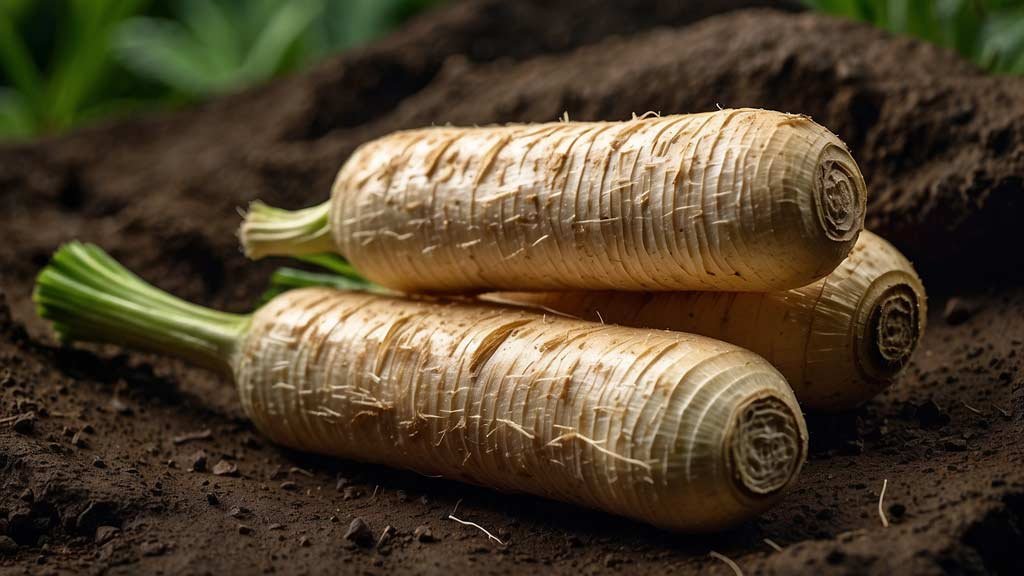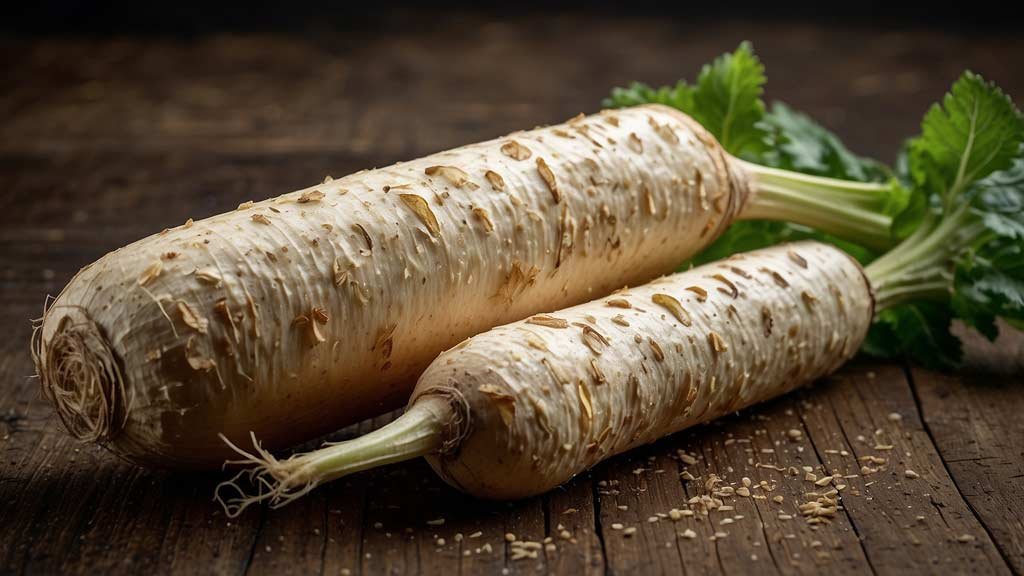A Fiery Root with a Long Story
Horseradish. You either love it, or you avoid it like the plague. That sinus-clearing burn is no accident—it’s chemistry in action. For centuries, people across Europe and Asia have grated, pickled, and powdered horseradish root, not only to wake up heavy foods but also to help the body fight off congestion, sluggish digestion, and seasonal infections. It’s sharp, it’s spicy, and it carries a personality all its own.
This humble root has been a kitchen staple and a folk remedy long before “immune boosting” became a marketing buzzword. Farmers would dig up its long, pale roots, scrub them down, and keep them stored for the winter months. When coughs and colds rolled through the village, a spoonful of freshly grated horseradish mixed with honey was often the first line of defense.
Now, science is catching up to tradition. Compounds in horseradish appear to support respiratory health, fight microbes, and even act as mild natural antibiotics. That sinus-opening heat? It’s the same chemical family that gives mustard and wasabi their bite—glucosinolates and their byproducts, especially allyl isothiocyanate. These compounds may sound technical, but your nose knows them instantly.
Table of Contents
What Makes Horseradish “Work”?
When you slice or grate fresh horseradish, enzymes in the plant get busy. They convert glucosinolates into isothiocyanates, sharp-smelling molecules that make your eyes water. This is plant defense chemistry—horseradish protects itself from pests, and in doing so, it provides humans with natural medicine.
The effects aren’t just in your sinuses. Studies suggest these compounds:
- Support immune defenses by stimulating white blood cell activity
- Act against bacteria such as Staphylococcus aureus and E. coli
- Help clear mucus from the lungs and sinuses
- Offer antioxidants that reduce cellular stress
It’s easy to think of horseradish as just a condiment, but under that heat is a whole pharmacy.
Horseradish and the Lungs
Ask anyone who’s ever taken a big spoonful of fresh horseradish—the airways open almost instantly. That’s more than just a quirky sensation. The volatile compounds in horseradish stimulate secretions in the respiratory tract, thinning mucus and making it easier to expel.
In folk practice, horseradish was grated and inhaled for sinus congestion. A warm poultice was sometimes applied to the chest to encourage circulation and open breathing. And mixtures of horseradish with vinegar or honey often served as cough remedies.
Modern herbalists still value horseradish for:
- Acute sinusitis when the head feels clogged and pressure builds
- Bronchitis where heavy mucus lingers
- Allergic congestion that doesn’t budge with simple teas
Of course, it’s no cure-all. Too much horseradish can irritate, and not everyone tolerates it. But in the right dose, it can feel like fresh air rushing through tight passages.
Horseradish and Immunity
Let’s be honest. People often reach for horseradish because it feels strong. It feels like it’s “killing something bad.” And in a way, it just might be.
Research points to antimicrobial actions. Isothiocyanates from horseradish inhibit the growth of bacteria and fungi. That doesn’t mean you can toss your antibiotics, but it does explain why traditional medicine leaned on it during infections.
Some preliminary studies suggest immune modulation, meaning horseradish may help balance rather than simply stimulate the immune system. It encourages responsiveness without overstimulating. That’s subtle but important.
Add to this its vitamin C content, minerals like potassium and calcium, and antioxidant capacity, and you’ve got a plant that genuinely supports resilience.
A Culinary Medicine
The kitchen is where horseradish shines. Few herbs straddle the line between food and medicine so naturally.
You can:
- Grate it fresh and mix with apple cider vinegar for a pungent tonic
- Stir into mustard or cream for sauces that cut through fatty meats
- Combine with honey for a sweet-spicy syrup against coughs
- Blend into beet salads, as is common in Eastern European cooking
Fresh root is strongest. The heat fades once grated and exposed to air, which is why commercial sauces add vinegar quickly—to trap that fire.
One simple preparation: grate fresh horseradish, add a splash of lemon juice, and spoon a bit on your plate when you feel stuffed up. The relief is often immediate.

Traditional Uses Across Cultures
- Europe: Used as a condiment with roasted meats, preserved in vinegar, and taken as a spring tonic for sluggish digestion.
- Russia and Eastern Europe: Blended with beets to make “khren,” a staple on holiday tables and also taken for colds.
- Britain: Traditionally served with beef and smoked fish.
- Germany and Austria: Integrated into mustards, sausages, and even medicinal liqueurs.
Everywhere it traveled, horseradish carried both flavor and function.
Safety and Cautions
Horseradish is strong stuff. That bite on your tongue is your body saying, “Careful.”
- Large doses can irritate the stomach.
- It may worsen gastritis or ulcers.
- Children under four shouldn’t take it as medicine.
- Pregnant or nursing women should be cautious with concentrated forms.
Applied externally, it can cause skin redness or even blisters if left too long. Folk poultices were always used briefly, and with good reason.
Growing and Harvesting Horseradish
This root is nearly indestructible once planted. Stick a piece in the ground, and you’ll likely have horseradish for years. It thrives in temperate climates, spreading underground with thick taproots.
Harvest in late fall, after the first frost, when the roots have built up strength. The flavor will be sharpest and most medicinal then. Wash, peel, and use fresh—or store in sand or a root cellar.
Drying diminishes its punch, but you can preserve some power by making tinctures or vinegar extracts.
My Take: Why Horseradish Matters
To me, horseradish represents the kind of everyday medicine we forget about. We rush to exotic superfoods while ignoring the scrappy root sitting in the corner of the market. It doesn’t look glamorous. It doesn’t have slick marketing. But it works, plain and simple.
There’s something satisfying about the way horseradish clears the head. It’s immediate, physical, undeniable. You don’t need to read a study to know it’s doing something real. Of course, the science helps confirm the old wisdom, but experience speaks volumes.
Maybe that’s why I keep a jar of homemade horseradish in the fridge. It’s a friend in the cold months, when lungs feel heavy and colds are knocking at the door. A spoonful here and there, and suddenly, you can breathe again.
Final Thoughts
Horseradish is more than a fiery garnish. It’s a traditional lung and immune ally, a kitchen medicine chest disguised as a root. It embodies the old saying that food can be medicine—if we pay attention to the plants we already know.
So next time you feel congested, or when winter foods weigh you down, consider turning to horseradish. Not in capsules or powders, but fresh, pungent, alive. That burn might just be the wake-up call your body needs.
Article Sources
At AncientHerbsWisdom, our content relies on reputable sources, including peer-reviewed studies, to substantiate the information presented in our articles. Our primary objective is to ensure our content is thoroughly fact-checked, maintaining a commitment to accuracy, reliability, and trustworthiness.
- Bauer, R., & Wagner, H. (1991). Efficacy of herbal drugs in upper respiratory tract infections and related conditions. Phytomedicine, 1(1), 1–15. https://doi.org/10.1016/S0944-7113(11)80028-4
- Binns, S. E., Hudson, J., Merali, S., & Arnason, J. T. (2002). Antiviral activity of characterized extracts from Echinacea spp. (Heliantheae: Asteraceae) against Herpes simplex virus (HSV-I). Planta Medica, 68(9), 780–783. https://doi.org/10.1055/s-2002-34520
(Note: This study provides context on immune-modulating herbs alongside horseradish.) - Blench, R., & van Wyk, B. E. (2008). Herbal medicine: Biomolecular and clinical aspects. CRC Press. https://www.ncbi.nlm.nih.gov/books/NBK92770/
- European Medicines Agency. (2012). Assessment report on Armoracia rusticana P. Gaertn., B. Mey. & Scherb., radix. EMA/HMPC/571122/2010. Retrieved from https://www.ema.europa.eu
- Holst, L., Haavik, S., Nordeng, H., & Rohde, J. (2011). Use of herbal preparations during pregnancy: A survey among 400 Norwegian women. Phytotherapy Research, 25(6), 806–812. https://doi.org/10.1002/ptr.3349
- Leja, M., Kamińska, I., Kramer, M., Maksylewicz-Kaul, A., Kammerer, D., Carle, R., & Baranska, M. (2010). Content of bioactive compounds and antioxidant activity in horseradish (Armoracia rusticana) roots and leaves. Food Chemistry, 121(4), 929–934. https://doi.org/10.1016/j.foodchem.2010.01.009
- Schmidt, E., Jirovetz, L., Buchbauer, G., Eller, G., Stoilova, I., Stoyanova, A., & Krastanov, A. (2005). Composition and antibacterial activities of the essential oil of horseradish (Armoracia rusticana). Flavour and Fragrance Journal, 20(6), 617–622. https://doi.org/10.1002/ffj.1504
- WHO Monographs on Selected Medicinal Plants. (1999). Armoracia rusticana radix (Vol. 1, pp. 29–38). World Health Organization. Retrieved from https://apps.who.int/iris/handle/10665/42052

